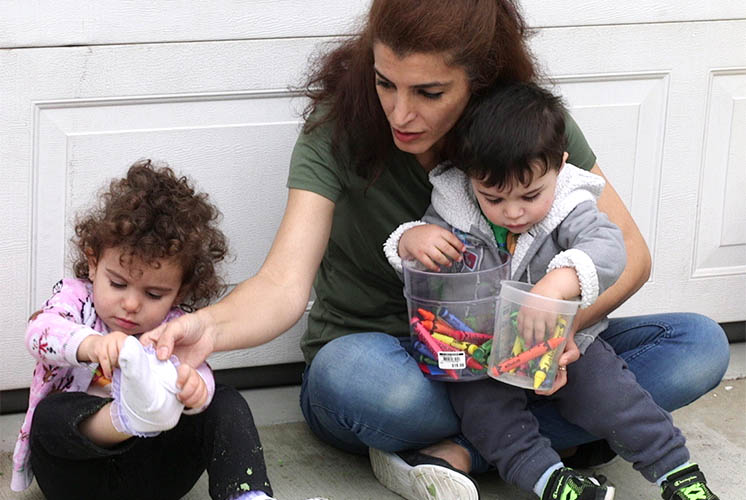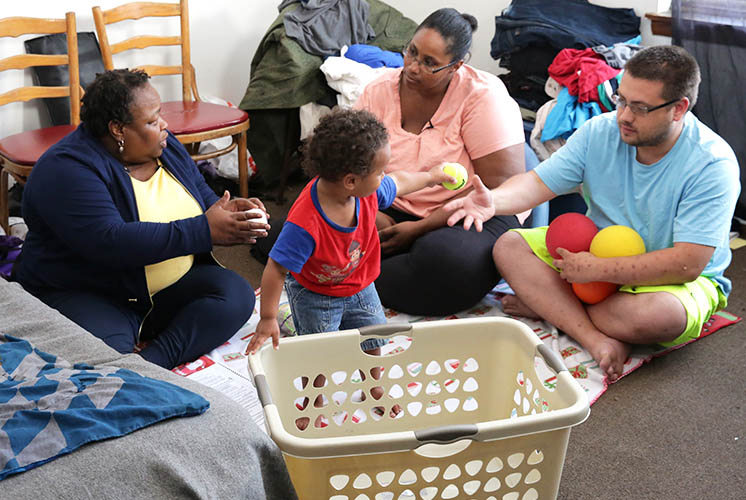 The idea of a curriculum for programs serving infants and toddlers has often raised many questions in the early care and education field about what it means to support the development and learning of very young children. In a comprehensive approach to research-based curriculum that is aligned with the ELOF, learning goals and content address all the developmental domains—Approaches to Learning; Social and Emotional; Language and Literacy; Cognition; and Perceptual, Motor, and Physical Development. Additionally, curricula should have an organized developmental scope and sequence that includes plans and materials for learning experiences based on developmental progressions and how young children learn (45 CFR §1302.32(a)(i)–(iii)). For infants and toddlers, this means that a “curriculum should include learning experiences to support infants’ and toddlers’ development at each level of the developmental progressions described in the ELOF: Birth to 9 months, 8 to 18 months, 16 to 36 months” (National Center on Early Childhood Development, Teaching, and Learning (NCECDTL), 2018, 2).
The idea of a curriculum for programs serving infants and toddlers has often raised many questions in the early care and education field about what it means to support the development and learning of very young children. In a comprehensive approach to research-based curriculum that is aligned with the ELOF, learning goals and content address all the developmental domains—Approaches to Learning; Social and Emotional; Language and Literacy; Cognition; and Perceptual, Motor, and Physical Development. Additionally, curricula should have an organized developmental scope and sequence that includes plans and materials for learning experiences based on developmental progressions and how young children learn (45 CFR §1302.32(a)(i)–(iii)). For infants and toddlers, this means that a “curriculum should include learning experiences to support infants’ and toddlers’ development at each level of the developmental progressions described in the ELOF: Birth to 9 months, 8 to 18 months, 16 to 36 months” (National Center on Early Childhood Development, Teaching, and Learning (NCECDTL), 2018, 2).
However, even with an organized and planned approach to infant toddler curriculum, specific principles about how infants and toddlers develop and learn still apply (NCECDTL, 2018). Although all the principles are important, the main one is that infants and toddlers learn through play, exploration, and interaction with objects and people in the context of meaningful relationships with trusted adults. Rote teaching of discrete skills is developmentally inappropriate.
Learning Through Play
What do we mean when we say that play is children’s work? What are infants and toddlers really learning in their play that forms the foundational skills for later work in school? The table below provides some examples of typical infant and toddler play experiences, their relationship to academic skill areas, and the unique role of social and emotional development as a bridge between play and learning.
| Play Experiences | ELOF Domain / Sub-Domain | What Children May Be Learning |
|---|---|---|
| Playing pat-a-cake | Language and Literacy/Language and Communication |
Imitation Social and emotional: I feel understood when you respond to my gestures. We have fun together. I like to imitate you. |
| Manipulating and mouthing books; being read to in home language or English | Language and Literacy/Emergent Literacy |
Vocabulary, memory Social and emotional: I like being close when we read together. It feels good to snuggle with you and hear my favorite story. |
| Small-group play at the water table with different-sized containers | Cognition/Exploration and Discovery; Emergent Mathematical Thinking |
Concepts of weight and volume Social and emotional: I learn how to take turns and share. |
| Building with blocks | Cognition/Emergent Mathematical Thinking |
Counting, sorting, beginning classification skills Social and emotional: I feel confident about what I can do when you clap for me as I build my block tower. |
Parents, family members, and education staff in Head Start infant toddler programs:
- Collaborate to develop individual learning goals; this may include identifying goals in an Individualized Family Service Plan, or IFSP, for children with identified disabilities
- Use the curriculum to identify the learning experiences they want children to have in the program
- Do what the curriculum suggests to create these learning opportunities, whether in group-care settings or at home
Ongoing assessment of children provides information that is used to individualize learning opportunities and interactions by identifying a child’s unique skills, interests, resources, needs, and progress. Some of the strategies for ongoing child assessment include:
- Documenting what children communicate, say, and do, and using the program’s ongoing child assessment tool to identify current functioning and emerging skills
- Communicating with parents, family members, and other caregivers about what they observe about their children in the home and other settings
- Identifying different ways in which children learn and individualizing the learning environment, adult-child interactions, and learning experiences
- Modifying the materials, experiences, or environment to encourage increased engagement and support development of new skills
In addition, through relationships with children, adults can use informal “teachable moments” that provide rich, responsive, and relevant learning experiences in unplanned and, often, unexpected ways. These are the learning experiences that often have the greatest effect. Skilled teaching staff plan for moments when they can intentionally support children’s individual learning goals in each area of development. For example, a family child care provider reinforces cognitive goals (memory, matching skills) when the child with whom she is finger painting notices that his red shirt matches the red paint and she makes a game out of naming all the other red things in the home that the child can find. Similarly, a teacher reinforces social, emotional, and approaches to learning goals and skills (conflict negotiation, emotional and behavioral self-regulation) when he helps two children negotiate to solve the problem of who gets to play with the fire truck by offering some choices for how the children can play with it (together or take turns) and identifying and validating the feelings they may be experiencing.
Implications for Practice
Children’s thinking and learning are guided by responsive caregiving. Understanding child development is an important tool for responding effectively to the children with whom you work and for supporting families who are learning these skills.
- Learn about the developmental milestones that take place in the early years—for example, cognitive and approaches to learning concepts such as imitation, object permanence, and pretend play—and the progression of learning from simple to more sophisticated skills that children demonstrate in their play.
- Use this knowledge to individualize the curriculum. Knowing the stages of development will allow you to anticipate what developmental task comes next and to provide appropriate experiences within the context of your curriculum’s scope and sequence. Your goal is to challenge each child in ways that draw out emerging skills by accurately reading his or her cues and responding with the appropriate support (e.g., helping a child learning to crawl by putting a favorite toy just a little out of reach right next to you and giving him a hug or a verbal “yes, you got your rattle!” when he gets it).
 Think about how everyday experiences at home or in group care involve concepts and skills across all the ELOF domains—Approaches to Learning; Social and Emotional; Language and Literacy; Cognitive; and Perceptual, Motor, and Physical Development. Recognize how these concepts and skills guide how you implement the curriculum. For example, arrival and departure rituals incorporate the cognitive skill of object permanence and communication skills such as receptive and expressive language; they also help build social and emotional skills such as resiliency and emotional functioning. Infants and toddlers at different developmental levels require different strategies to cope with their parent or family member leaving them with another caregiver. You can help parents and families prepare for social and emotional changes—such as crying, clinging, and separation anxiety—that often occur when infants develop this new cognitive understanding later in the first year of life.
Think about how everyday experiences at home or in group care involve concepts and skills across all the ELOF domains—Approaches to Learning; Social and Emotional; Language and Literacy; Cognitive; and Perceptual, Motor, and Physical Development. Recognize how these concepts and skills guide how you implement the curriculum. For example, arrival and departure rituals incorporate the cognitive skill of object permanence and communication skills such as receptive and expressive language; they also help build social and emotional skills such as resiliency and emotional functioning. Infants and toddlers at different developmental levels require different strategies to cope with their parent or family member leaving them with another caregiver. You can help parents and families prepare for social and emotional changes—such as crying, clinging, and separation anxiety—that often occur when infants develop this new cognitive understanding later in the first year of life.- As you think about your curriculum, remember that goals for learning involve all the ELOF domains. When these domains are integrated and work together, they promote healthy developmental functioning.



